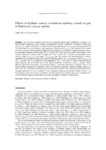Mostrar o rexistro simple do ítem
Effects of rhythmic sensory stimulation (auditory, visual) on gait in Parkinson’s disease patients
| dc.contributor.author | Arias, Pablo | |
| dc.contributor.author | Cudeiro, Javier | |
| dc.date.accessioned | 2015-05-19T08:25:14Z | |
| dc.date.available | 2015-05-19T08:25:14Z | |
| dc.date.issued | 2008-01-23 | |
| dc.identifier.citation | Arias P, Cudeiro J. Effects of rhythmic sensory stimulation (auditory, visual) on gait in Parkinson’s disease patients. Ex Brain Res. 2008;186:589-601 | es_ES |
| dc.identifier.uri | http://hdl.handle.net/2183/14522 | |
| dc.description.abstract | [Abstract] This study has focused on how sensory stimulation affects gait in Parkinson’s disease (PD). The kinematic parameters of gait [cadence, step amplitude, velocity, coefficient of variation of stride time (CVstride-time), and the coefficient of variation of the step amplitude (CVstep-amplitude)] were analysed in 25 PD patients and 10 control subjects. Step amplitude, velocity and CVstride-time were altered in the patients with PD. However, when kinematic parameters were analysed as a function of disease severity, none of the parameters differed between early PD (I–II Hoehn and Yahr) and the controls. Nevertheless, more severely affected PD patients (III–IV Hoehn and Yahr) walked with a reduced step amplitude, lower velocity, higher CVstride-time, and higher CVstep-amplitude than the controls. The administration of auditory stimulation at a frequency matching the preferred walking cadence led to a decrease in the CVstride-time in PDIII–IV patients, and to an increase in step amplitude in PDIII–IV and controls. Visual stimulation at the same frequency did not modify any of the altered kinematic parameters in PDIII–IV patients. When different stimulation frequencies were utilised, auditory stimulation significantly changed some of the altered walking parameters in Parkinson patients. Frequencies matching preferred walking cadence or above this, up to the fastest walking, were those that seem to interact most effectively with the abnormal kinematic parameters in PDIII–IV patients. Visual stimulation negatively modulated cadence in PDIII–IV in the frequency range used. Sensory stimulation facilitates gait in PD. Studies using sensory stimulation as a tool to facilitate walking should take into account the grade of disability of the patients. | es_ES |
| dc.description.sponsorship | Galicia. Consellería de Innovación, Industria e Comercio; PGIDIT06PXIC137004PN | es_ES |
| dc.description.sponsorship | Galicia. Consellería de Educación; 2007/000140-0 | |
| dc.language.iso | eng | es_ES |
| dc.publisher | Springer | es_ES |
| dc.relation.uri | http://dx.doi.org/10.1007/s00221-007-1263-y | es_ES |
| dc.rights | The final publication is avaliable at link.springer.com | es_ES |
| dc.subject | Parkinson | es_ES |
| dc.subject | Gait | es_ES |
| dc.subject | Sensory stimulation | es_ES |
| dc.subject | Rhythm | es_ES |
| dc.title | Effects of rhythmic sensory stimulation (auditory, visual) on gait in Parkinson’s disease patients | es_ES |
| dc.type | info:eu-repo/semantics/article | es_ES |
| dc.rights.access | info:eu-repo/semantics/openAccess | es_ES |
Ficheiros no ítem
Este ítem aparece na(s) seguinte(s) colección(s)
-
GI-NEURO - Artigos [132]






